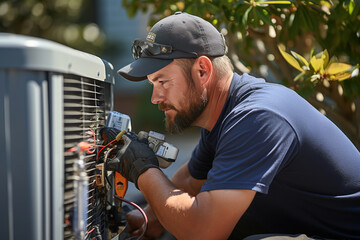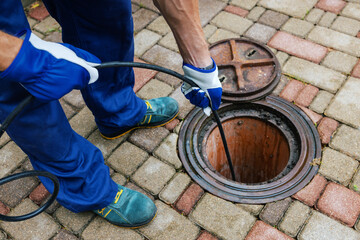Understanding the role of HVAC Round Rock in heating, ventilation, and air conditioning is essential to recognizing how it ensures indoor comfort. HVAC systems are designed to regulate temperature, humidity, and air quality within residential, commercial, and industrial spaces, creating an environment that is comfortable, healthy, and energy-efficient.
These systems are complex networks of equipment and controls that work together to provide consistent indoor climate control.
The three main components—heating, ventilation, and air conditioning—each play a specific role in maintaining a balanced indoor environment. The effectiveness of an HVAC system depends on the proper design, installation, maintenance, and operation of these components, making HVAC a critical aspect of modern building infrastructure.
Heating is one of the primary functions of an HVAC system, providing warmth during colder months to maintain a comfortable indoor temperature. Heating systems can be powered by various energy sources, including electricity, natural gas, and renewable energy. Common heating methods include furnaces, boilers, and heat pumps. Furnaces work by burning fuel or using electricity to generate heat, which is then distributed throughout the building via ductwork or radiators. Boilers heat water, which is circulated through pipes to radiators or baseboard heaters, releasing heat into the surrounding space. Heat pumps use a refrigeration cycle to extract heat from the outside air or ground and transfer it indoors. The heating component of an HVAC system must be properly sized and calibrated to ensure consistent and efficient warmth without excessive energy consumption. Proper insulation and sealing of the building envelope also contribute to the efficiency of the heating system by preventing heat loss and reducing the overall demand for heating.
Ventilation is another critical function of an HVAC system, ensuring a continuous supply of fresh air while removing stale air, moisture, and indoor pollutants. Proper ventilation is essential for maintaining good indoor air quality and preventing issues such as mold growth, condensation, and the buildup of harmful gases like carbon monoxide. There are two main types of ventilation: natural and mechanical. Natural ventilation relies on openings such as windows, doors, and vents to allow fresh air to enter and stale air to escape. Mechanical ventilation uses fans, ducts, and air handlers to control the flow of air in and out of the building. HVAC systems often incorporate air filtration and purification systems to remove dust, allergens, and contaminants from the air before it is circulated. Heat recovery ventilators (HRVs) and energy recovery ventilators (ERVs) are also used to improve ventilation efficiency by transferring heat or moisture between incoming and outgoing air streams. Effective ventilation ensures that indoor air remains fresh and healthy, reducing the risk of respiratory issues and improving overall comfort.
Air conditioning is the third core function of an HVAC system, providing cooling and dehumidification during warmer months. Air conditioning systems work by removing heat and moisture from indoor air, creating a cooler and more comfortable environment. Most air conditioning systems use a refrigeration cycle that involves the compression and expansion of a refrigerant to absorb and release heat. The process begins with the evaporator coil, where the refrigerant absorbs heat from indoor air. The heated refrigerant is then compressed and transported to the condenser coil, where it releases the heat to the outside air. The cooled refrigerant returns to the evaporator coil to repeat the cycle. Central air conditioning systems distribute cooled air through a network of ducts and vents, while ductless systems use individual air handlers to cool specific areas. Proper sizing, installation, and maintenance of the air conditioning system are essential for efficient operation and consistent cooling performance. High-efficiency air conditioners use advanced technologies such as variable-speed compressors and smart controls to optimize energy use and maintain a consistent temperature.
HVAC systems also play a key role in maintaining humidity levels within an indoor space. High humidity can lead to discomfort, mold growth, and damage to building materials, while low humidity can cause dryness and respiratory issues. HVAC systems use humidifiers and dehumidifiers to regulate moisture levels, ensuring that indoor air remains within a comfortable and healthy range. Dehumidifiers work by condensing moisture from the air and draining it away, while humidifiers add moisture to the air using water vapor or steam. Balancing humidity levels improves comfort, preserves indoor air quality, and protects furnishings and structural components from moisture-related damage.
Modern HVAC systems are designed to provide energy-efficient performance while reducing environmental impact. Energy efficiency is achieved through advanced technologies, smart controls, and proper system design. Programmable thermostats, zoning systems, and occupancy sensors allow HVAC systems to adjust temperature and airflow based on occupancy and usage patterns, reducing energy waste. High-efficiency heating and cooling equipment, such as condensing furnaces and heat pumps, use less energy while delivering consistent performance. Improved building insulation, sealing, and ventilation also contribute to energy efficiency by reducing the demand for heating and cooling. Renewable energy sources, such as solar and geothermal, are increasingly integrated into HVAC systems to further reduce reliance on fossil fuels and minimize carbon emissions.
The installation of an HVAC system requires careful planning and execution to ensure optimal performance and efficiency. HVAC contractors assess the size and layout of the building, climate conditions, and energy requirements to design a system that meets the specific needs of the space. Proper sizing of heating and cooling equipment is crucial to avoid issues such as uneven temperatures, excessive energy consumption, and premature equipment failure. Ductwork design and installation also play a key role in system efficiency, as leaks, poor insulation, and improper airflow can reduce performance and increase energy costs. HVAC professionals follow industry standards and building codes to ensure that the system is installed safely and correctly.
Maintenance is essential to the long-term performance and efficiency of an HVAC system. Regular maintenance includes cleaning and replacing air filters, inspecting and lubricating moving parts, checking refrigerant levels, and testing system controls. Annual inspections by a qualified HVAC technician help identify potential issues before they become major problems, reducing the risk of system failure and costly repairs. Cleaning and sealing ductwork, calibrating thermostats, and testing airflow are also part of routine maintenance. Proper maintenance extends the lifespan of HVAC equipment, improves energy efficiency, and ensures consistent comfort and air quality.
HVAC systems have also become more sophisticated with the integration of smart technology and automation. Smart thermostats, remote monitoring systems, and mobile apps allow property owners to control and monitor their HVAC systems from anywhere. These systems use data and algorithms to optimize heating, cooling, and ventilation based on real-time conditions and user preferences. For example, a smart thermostat can learn a user’s schedule and adjust temperature settings accordingly to minimize energy use. Remote diagnostics and predictive maintenance also enable HVAC technicians to identify and resolve issues more quickly, improving system reliability and reducing downtime.
Environmental sustainability is becoming an increasingly important consideration in HVAC system design and operation. High-efficiency equipment, eco-friendly refrigerants, and renewable energy sources help reduce the carbon footprint of HVAC systems. Building codes and energy standards encourage the use of energy-efficient HVAC solutions and environmentally responsible practices. Advances in heat pump technology, heat recovery systems, and energy-efficient ventilation contribute to lower energy consumption and reduced environmental impact. HVAC systems that prioritize energy efficiency and sustainability provide long-term cost savings and environmental benefits.
The role of HVAC in heating, ventilation, and air conditioning is essential to maintaining indoor comfort, health, and efficiency. HVAC systems regulate temperature, humidity, and air quality, creating a balanced and comfortable indoor environment. Heating systems provide warmth during cold weather, ventilation systems ensure a continuous supply of fresh air, and air conditioning systems remove heat and humidity during warm weather. Energy-efficient design, proper installation, regular maintenance, and smart technology enhance the performance and reliability of HVAC systems. As environmental concerns and energy costs continue to rise, the demand for high-efficiency, sustainable HVAC solutions is expected to grow. Understanding the role and operation of HVAC systems helps property owners make informed decisions and maximize the benefits of modern climate control technology.





 Plumber are also skilled at troubleshooting. They can diagnose problems based on a client’s description or their inspection and find practical solutions.
Plumber are also skilled at troubleshooting. They can diagnose problems based on a client’s description or their inspection and find practical solutions.
 Mold tests can be performed on air, swabs, and bulk samples.
Mold tests can be performed on air, swabs, and bulk samples.
